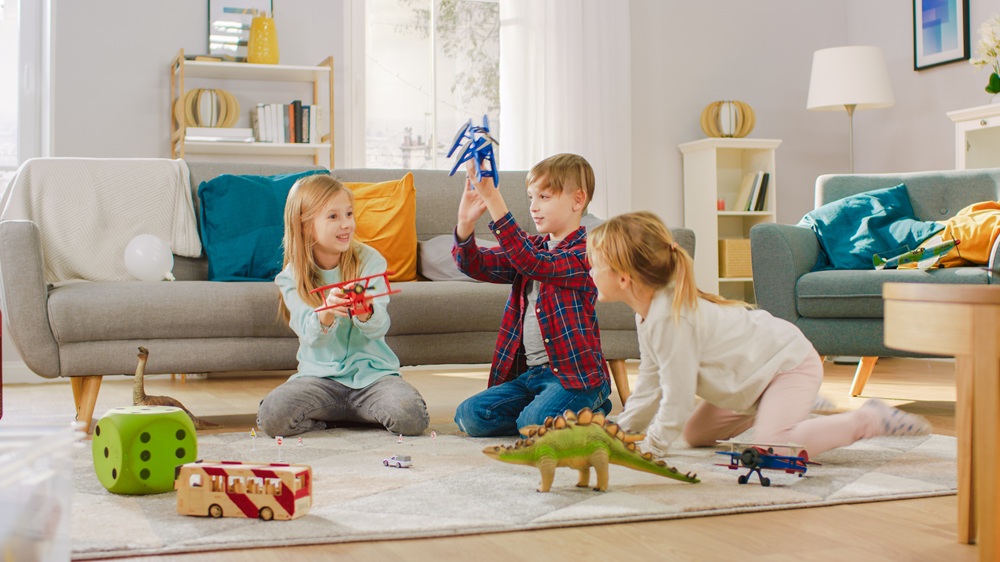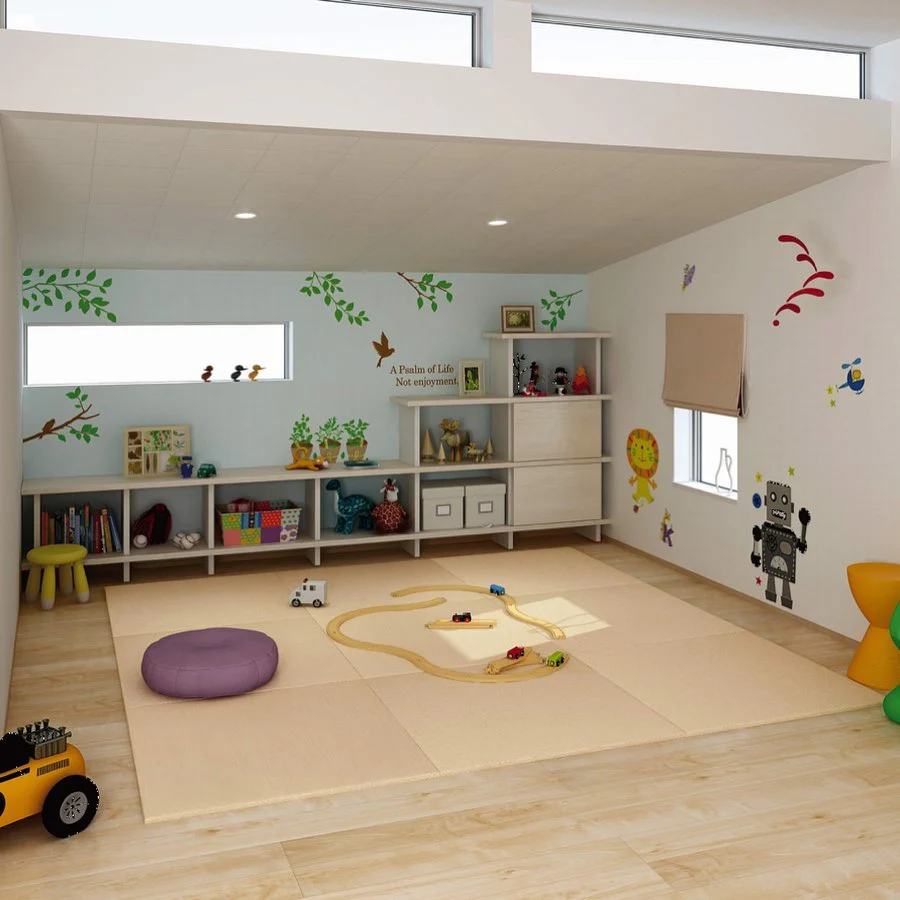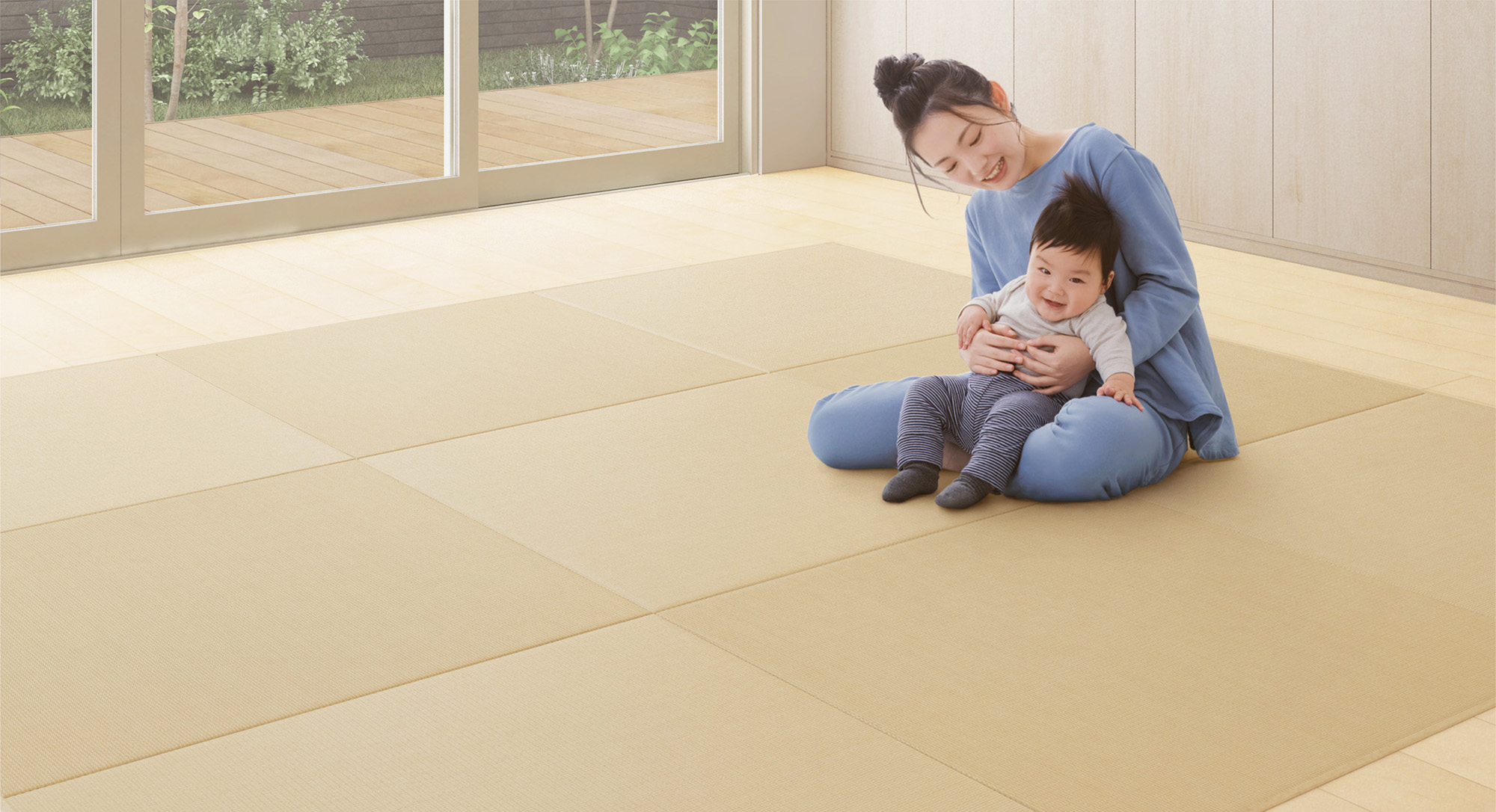Create a Calm Playroom: A Tatami Mat for Kids’ Rooms That Parents Love

At Interra USA, our mission is simple: bring the comfort, durability, and quiet beauty of authentic Japanese materials into American homes. If you’re designing a kids’ room or carving out a play area in a shared living space, a tatami mat for kids’ rooms is one of the most effective upgrades you can make. Our unit (oki) tatami tiles are made in Japan and arrive as modular squares you simply place like a rug—no tools, no adhesives, and no remodeling required. Each tile is approximately 32.3″ × 32.3″ (820 × 820 mm) and ~13 mm thick with a slip-proof backing, so your layout feels stable from day one and can expand as your child grows.
Beyond the convenience, there’s real performance underfoot. The surface is DAIKEN’s resin-coated, machine-made washi (paper) facing—engineered for families. It’s designed to be water-repellent and stain-resistant for quick wipe-ups, and it’s tested to have about three times the wear resistance of general rush-based tatami, so it stands up well to toy traffic and frequent cleaning. These are qualities that matter in a kids’ zone, especially when you want a serene, design-forward look without the puzzle-piece seams of foam mats.
And the look? Tatami’s quiet grid and natural texture complement Japandi—the calming blend of Japanese minimalism and Scandinavian warmth that’s stayed firmly in the U.S. design conversation. Editorial coverage for 2025 highlights Japandi as a go-to for serenity, texture, and natural materials—exactly what you want where kids play, nap, or read.
As you can see, there are many advantages to using tatami mats in a child’s room. In this article, we’ll take a closer look at why tatami is such an effective choice for creating kids’ spaces. If you’re planning a comfortable play area for your child, we hope you’ll read on.
INDEX
- Why Tatami Fits Kids’ Rooms (and Japandi Homes)
- Planning Your Tatami Play Zone
- Safety & Care for Families
- Style Guide: Colors That Grow With Your Child
- How to Buy (Interra USA)
- FAQ — Tatami for Kids’ Rooms
- Summary & Next Step
Why Tatami Fits Kids’ Rooms (and Japandi Homes)

Soft underfoot comfort and everyday durability
Kids sit, kneel, sprawl, and scoot—your flooring should make all of that comfortable and safe. A tatami mat for kids’ rooms adds gentle cushioning and a non-slippery feel without becoming squishy or unstable under furniture. The DAIKEN facing we use is tested against abrasion (paper #180, 100 revolutions, 250 g × 2), and outperforms general rush-based tatami by roughly 3× in wear resistance—reassuring for households that see daily play and quick cleanups.
Mold- and stain-resistant, wipe-clean surface
Family rooms see spills. DAIKEN’s resin-coated surface is waterproof and stain-resistant, so most accidents—from juice to marker smudges—wipe away with a lightly damp cloth. It’s the “clean-it-and-move-on” performance busy parents need.
Minimalist look that calms visual clutter (Japandi/Zen)
Tatami naturally orders a room. Its low-profile, repeating grid defines a zone and quiets the eye—perfectly aligning with Japandi’s “fewer, better” ethos and generous negative space, an aesthetic U.S. editors continue to champion in 2025.
Built for real life (renters and multipurpose rooms)
Our unit tatami tiles ship as individual squares—820 × 820 mm, ~13 mm thick—with a slip-proof sheet on the back. Lay them directly on hard floors to create a play zone that protects the surface below; lift or rearrange them whenever you like. Our tatami tiles meet Japanese standards for a formaldehyde-labeling exemption—something many parents appreciate when they review our material disclosures.
Planning Your Tatami Play Zone

Designing with unit tiles is delightfully simple—and that simplicity is where the modular system shines for families. Because each square is the same size, you can “tile” your play zone like Lego, starting small and expanding later.
Starter layouts we see parents love:
- 2 tiles (approx. 64.6″ × 32.3″): a tidy reading nook beside a crib or daybed.
- 4 tiles (2×2, approx. 64.6″ square): a compact square for blocks, puzzles, or toddler play.
- 6 tiles (2×3, approx. 96.9″ × 64.6″): a roomy zone for siblings or combined play/sitting.
All of these keep a low profile for door clearances and work well in the corner of a living room or a dedicated kids’ room. Specs and sizing remain consistent across the line so you can add tiles later without worrying about mismatched dimensions.
A layout trick we recommend: rotate every other tile 90° so the weave catches light differently—this subtle checkerboard effect adds definition and hides micro scuffs from daily use. Place heavy furniture (shelves or a small sofa) just off the tatami edge to visually “frame” the zone and discourage tile creep. On hard floors, the slip-proof backing keeps layouts stable; on low-pile carpet, keep the footprint compact and align seams snugly for best results.
Float, move, evolve. Because installation is truly “place-and-lay,” a tatami play area can migrate as your needs change: under a lofted bed in elementary years, then beside a desk for reading or crafts later. Our corporate overview echoes this flexibility—unit/oki tatami installs like a rug and can be moved “anytime anywhere,” which is especially appreciated by renters.
Safety & Care for Families
Tatami’s maintenance is refreshingly light, especially compared with area rugs that trap crumbs and dust.
Daily/weekly routine: vacuum gently along the grain using a hard-floor attachment (no beater brush). Follow with a light wipe—again along the grain—using a well-wrung cloth. Good airflow (open a window or run a fan) speeds dry time and helps the surface reset. These simple habits are widely recommended by tatami care guides and align with our product’s water-repellent finish.
Spill response: blot first to lift moisture, then wipe and dry. For pigmented liquids, blot thoroughly before wiping; the DAIKEN resin-coated facing is designed for stain resistance, so prompt attention is typically all that’s needed. Avoid overly wet mopping—keeping moisture to a minimum is better for the seams and surface.
Sunlight & ventilation: as with many natural-look materials, prolonged direct sun can shift color over time. Simple shading (curtains, blinds) and regular ventilation keep your play zone looking consistent from season to season. For occasional deeper freshening, some Japanese how-tos suggest a diluted mild-acid wipe followed by a dry wipe and ventilation; if you try this, always spot-test and keep the cloth only slightly damp.
Style Guide: Colors That Grow With Your Child

A kids’ room can be playful and polished at the same time. We curate our lines so you can build a timeless base and evolve the accents as your child’s interests change.
Seiryu features a modern, smooth tatami surface in versatile tones. YOUNG GRASS adds a fresh green note that pairs beautifully with light woods; WHITE BROWN and CHERRY GRAY serve as flexible neutrals for Japandi rooms.
Sazanami introduces a subtle, contemporary texture that reads clean rather than busy—ideal for small rooms where you want visual quiet. It’s offered in WHITE BROWN, CHERRY GRAY, and MAROON, with the same easy installation and family-friendly surface.
Honami is woven with three different weft thread colors, creating a slightly richer look that transitions well from nursery to “big-kid” room. If you’d like to feel the texture first, we offer cut samples so you can compare colorways at home before ordering.
Saien and Saien Sparkle bring cheerful options and just-enough sheen for accent tiling, and their product pages reiterate practical benefits (slip & stain resistance; durability claims with test details) that parents value. Many customers mix a calm neutral field with one or two accent tiles in green or cocoa for a “kid-friendly Japandi” palette.
How to Buy (Interra USA)
We keep the buying process straightforward—because family life is busy enough.
- Pick your series and color. Browse our Unit Tatami collection to compare textures (Seiryu, Sazanami, Honami, Saien/Saien–Sparkle) and view current pricing and promotions. When available, you’ll see banners for limited-time free shipping at the top of the shop and on collection pages.
- Count your tiles. Each tile is 32.3″ × 32.3″ (820 × 820 mm), ~13 mm thick, and about 3 kg (6.61 lb). A 2-tile strip works for a reading nook, 4 tiles (2×2) make a great compact square play zone, and 6 tiles (2×3) create a roomier area for siblings or multipurpose setups.
- Delivery & what to expect. Items typically ship within about a week, and when promotions are active, they’ll be called out near the “Delivery” section (for example, “FREE SHIPPING (Limited Time Only)”). Your mats arrive as individual tiles in a cardboard case—just unbox, place, and play.
Want to sample first? Order cut samples for any tatami mats; they’re a quick way to preview color and texture in your actual lighting before committing to a full layout.
FAQ — Tatami for Kids’ Rooms
Q1. Is tatami okay with snacks, sippy cups, and art time?
A1. Yes. The DAIKEN surface we use is water-repellent and stain-resistant. Blot spills first, then wipe lightly along the grain and let the area air-dry. For pigmented liquids, prompt blotting makes the difference; the resin-coated surface is designed to resist stains with ordinary care.
Q2. How does tatami compare to foam play mats?
A2. Tatami offers a firmer, furniture-friendly feel that children can build on without wobble, plus a more refined look that blends into living spaces. Just as important for busy homes, DAIKEN’s facing is tested to be about 3× more wear-resistant than general rush-based tatami, and it’s designed for quick wipe-ups—family-proof qualities we prioritize.
Q3. Will the tiles slip on hardwood, tile, or LVP?
A3. The back of each tile uses a slip-proof sheet for stability on hard surfaces. On low-pile carpet, keep layouts compact and align seams snugly for best results.
Q4. What about material safety?
A4. Our tatami tiles qualify for a formaldehyde-labeling exemption under Japanese regulations—a detail many families look for when comparing material disclosures.
Q5. How do I clean tatami day to day?
A5. Vacuum gently along the grain (no beater brush), then wipe with a well-wrung cloth along the grain. Keep moisture minimal and ventilate so the surface dries quickly.
Summary & Next Step
We built our tatami offering around real family life: soft underfoot, wipe-clean, and modular—with a calming aesthetic that plays nicely with toys, books, and daily routines. Whether you call the look Japandi, minimalist, or simply “less visual noise,” tatami helps you create a kids’ zone that stays tidy and feels good to be in. Each Interra USA tile arrives ready to place, in a size that’s easy to plan: 32.3″ square, ~13 mm thick, with a slip-proof backing to keep things put. And because they’re modular, your layout can grow from a cozy two-tile reading corner into a six-tile play stage as your child’s needs evolve—without buying a new rug every time.
When you’re ready, explore our Unit Tatami collection, choose your colorway, and start with a 4- or 6-tile layout. From there, it’s a few clicks to checkout and just days to delivery—unbox, place, and enjoy your new calm play space.
Reference link:
The 6 Top Home Décor Trends of 2025, According to Experts | Who What Wear
Tour a Lush and Moody Atlanta Home With Japandi Design Influences | Architectural Digest
How To Clean Tatami Mats? Tips To Properly Care The Tatami Mats – tatami.us

